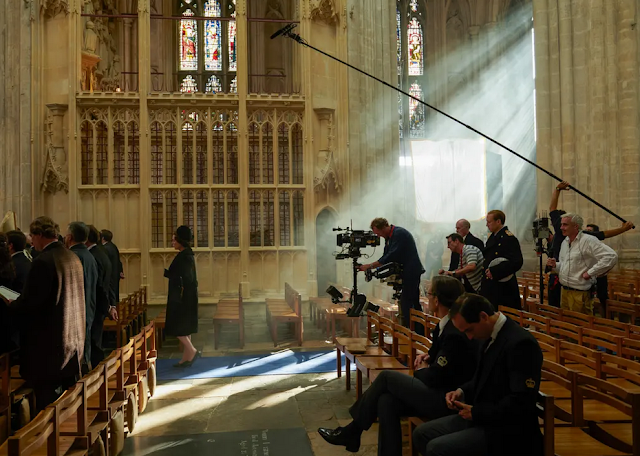I pulled books we have two copies of--there aren't usually too many--to put on display:
"This Winter... Start a 2-Person Book Group".
I think it's a great idea and I did this last year too, but the books don't really sell that well.
Many, you can see, are old "of-the-moment" bestsellers.
For a lot of these, it's really a Last Chance Before I Recycle You.
(Some are keepers, and I've added more, as I come across them--including E. M. Forster's Passage to India, and Love Medicine, by local author, bookstore owner, and National Book Award winner Louise Erdrich [her Birchbark Books blog].)
So, yeah--there are lots of old bestsellers that everyone bought and read, or classics that were assigned in school--The Red Badge of Courage, The Scarlet Letter, Catcher in the Rye.
Currently, we have four (4) copies of Eat, Pray, Love and of Rick Warren's Purpose Driven Life.
Will these still be read in fifty years, or even twenty?
Some will, maybe.
Purpose reminds me of Oswald Chambers's daily Christian devotional My Utmost for His Highest (1924). We occasionally get copies of it, and I guess it's still popular? George W. Bush liked it, according to Wikipedia.
But Utmost is an old chestnut and it never sells.
Classics that people choose to read on their own, not for school, usually sell fast.
We get plenty of Jane Austens donated, for instance, and Charles Dickenses, but rarely have two copies of any title.
There are some crossovers too––popular and read in schools––such as Lord of the Flies, which always sells. And tons of Bibles & Shakespeare come and go all the time.
Mark Twain is sort of neither/both.
We keep no inventory, and since I don't work the cash register anymore, I don't get to see who buys which books.
But judging from what I see on the shelves, here's a rough guide to what sells and what doesn't.
Best Sellers
Fiction--all sorts, but especially pop–crime/thrillers (James Patterson, Lisa Scottoline, MN author John Sanford's "Prey" series), and old standbys such as Agatha Christie (but not, surprisingly, Sherlock Holmes books) @ only 49¢ each
(. . . Also surprisingly, romance books––also 49¢--are slow sellers)
--and literary fiction (Camus, Elena Ferrante, Toni Morrison) and most classics (Tolstoy, Hemingway, Woolf), except for authors out of favor, such as Rudyard Kipling (and, for some reason, Henry James never sells, except his Turn of the Screw, but James Joyce does, so readability's not the issue),
some pop-classics beloved by men especially, it seems-- not sure what to call these--such as On the Road, Fight Club, and anything by David Foster Wallace;
and sci-fi, if we have it, which we usually don't;
cookbooks;
kids picture books (49¢ each);
current magazines (25¢ each)--old copies of National Geographic and The New Yorker sell, but other back issues, forget it;
arts & DIY (Van Gogh & knitting, yes--home repairs, not so much);
books about trains (this surprised me);
books about witchcraft, astrology, dragons;
Buddhism (emotional regulation?) for Westerners (Pema Chodron, Thich Nhat Hanh, and even older writers such as Alan Watts);
very-current affairs & pre–Vietnam War United States history, but not mid-range history: books about the era of the Bushes, Bill Clinton, and Reagan don't sell, and neither does feminism; history of other countries doesn't sell particularly well either;
extra-cool "cool old books";
How-to-Write books of the encouraging kind, not the technical kind (some standards remain good sellers, such as Bird by Bird by Annie LaMott, Writing Down the Bones by Natalie Goldberg, and So You Want to Write by Brenda Ueland);
current books about race (White Fragility), and classics (Frederick Douglass and Autobiography of Malcolm X, but not Roots).*
Books about Indigenous peoples.
Middling Sellers
Books about science and nature (even classics, like Thoreau or Annie Dillard, or like-new ones with neat pictures--I'd thought these would sell better);
YA (young adult--I think these need to be super new: I overheard a teenager saying that if books are old enough to be in this store, they already know about and have read them);
Self-care & psychology, including 12-Step books;
Christianity and other religions (Bibles are steady, theology is slow);
travel and places; world languages; poetry;
pet books; gardening (sells well in early spring);
biographies (these date fast--forget books about old TV stars);
Music---it depends. Some sheet music sells, biographies of some musicians (Bob Dylan) too; others (Jennifer Lopez, Aaron Copland), not.
Worst Sellers
Books about sports do not move--especially books about golf & fishing, but even soccer and yoga;
business & management--blah;
health, childbirth and child rearing (do people only want the most current info?);
"cool old books" that aren't great but I wish would sell just for how cool their covers are;
drama--plays & books about theater almost never sell;
inspirational books about angels or family, a la "The Love of a Sister" or "There's Nothing Like a Grandparent" (again, I was surprised--I'd thought these would be popular, but nope--even if they're like-new);
Old bestsellers made into pop movies such as Bridget Jones's Diary or The Devil Wears Prada, or anything with a title such as The Gardener's Daughter's Secret Recipe for Giraffes,
and mid-century authors such as John Irving, John Updike, Mary McCarthy, et al.
Mid-centuryish politics and social sciences (no Margaret Mead or Gloria Steinem, no Eisenhower or even Watergate; Kennedy's assassination is old hat--I'm going to try a display of the many books we have about him next week--the anniversary of his murder--and see if they go, but they don't usually move off the shelf)
Authors who fell from grace, such as once-favored son of MN Garrison Keillor, Bill Cosby, and Woody Allen;
and right-wingers such as Bill O'Reilly & Ann Colter (someone took a book with her face on the spine and hid it behind the others--this happens sometimes).
The public has spoken.
These never sell and can go right to recycling.













































